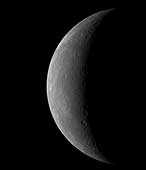|
COMETS EARTH JUPITER KUIPER BELT MARS MERCURY METEORITES NEPTUNE OORT CLOUD PLUTO SATURN SOLAR SYSTEM SPACE SUN URANUS VENUS ORDER PRINTS
PHOTO CATEGORIES SCIENCEVIEWS AMERICAN INDIAN AMPHIBIANS BIRDS BUGS FINE ART FOSSILS THE ISLANDS HISTORICAL PHOTOS MAMMALS OTHER PARKS PLANTS RELIGIOUS REPTILES SCIENCEVIEWS PRINTS
|
Related Documents
Download Options
As MESSENGER neared Mercury on January 14, 2008, the spacecraft’s Wide Angle Camera on the Mercury Dual Imaging System (MDIS) took images of the planet through each of its 11 filters. This image of the planet’s full crescent was taken using the 7th filter, in light near the far-red end of the visible spectrum (750 nm). The image shows portions of Mercury previously seen by Mariner 10, but when Mariner 10 flew by the planet at each of its encounters the Sun was nearly overhead. For this MESSENGER flyby, in contrast, the Sun is shining obliquely on regions near the day/night boundary (called the terminator) on the right-hand side of the crescent, revealing the surface topography in sharp relief. This image illustrates how MESSENGER, during its future flybys and subsequent orbital mission, will teach us much about the portion of Mercury already imaged by Mariner 10, and not just because of its superior camera and close proximity to the planet. The solar lighting geometry makes an enormous difference. This picture provides a global context for the MDIS Narrow Angle Camera (NAC) images taken while MESSENGER was inbound. For example, the NAC image of the crater Vivaldi, released earlier this week, would fit as a small patch on the terminator just above the center of the crescent. The already released image that includes the crater Sholem Aleichem shows a part of Mercury near the top of the crescent. More NAC images of the incoming crescent will be released in the future. This image was taken about 80 minutes before closest approach from a distance of about 27,000 kilometers (17,000 miles) and shows features as small as 10 kilometers (6 miles). Credit: NASA/Johns Hopkins University Applied Physics Laboratory/Carnegie Institution of Washington |
